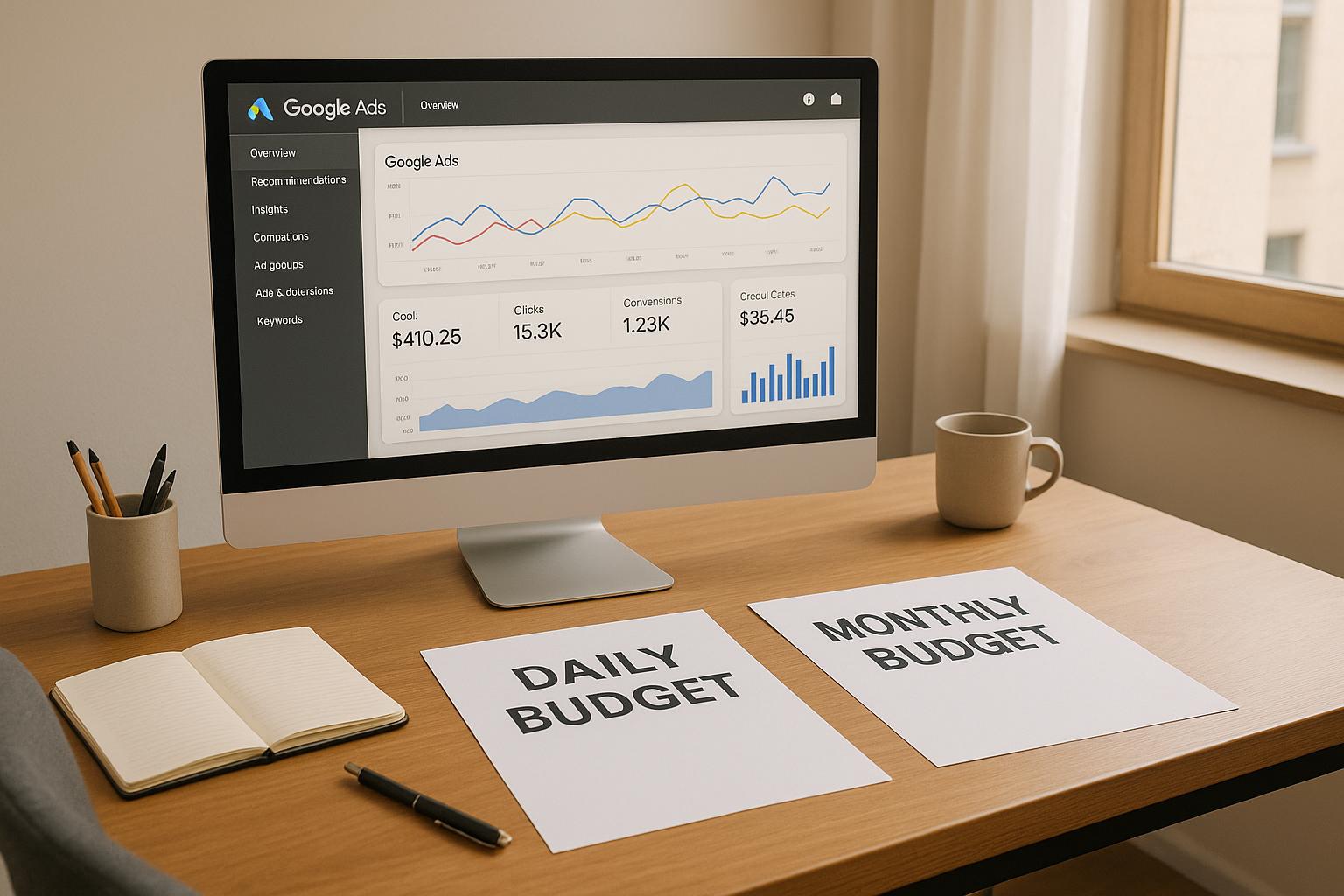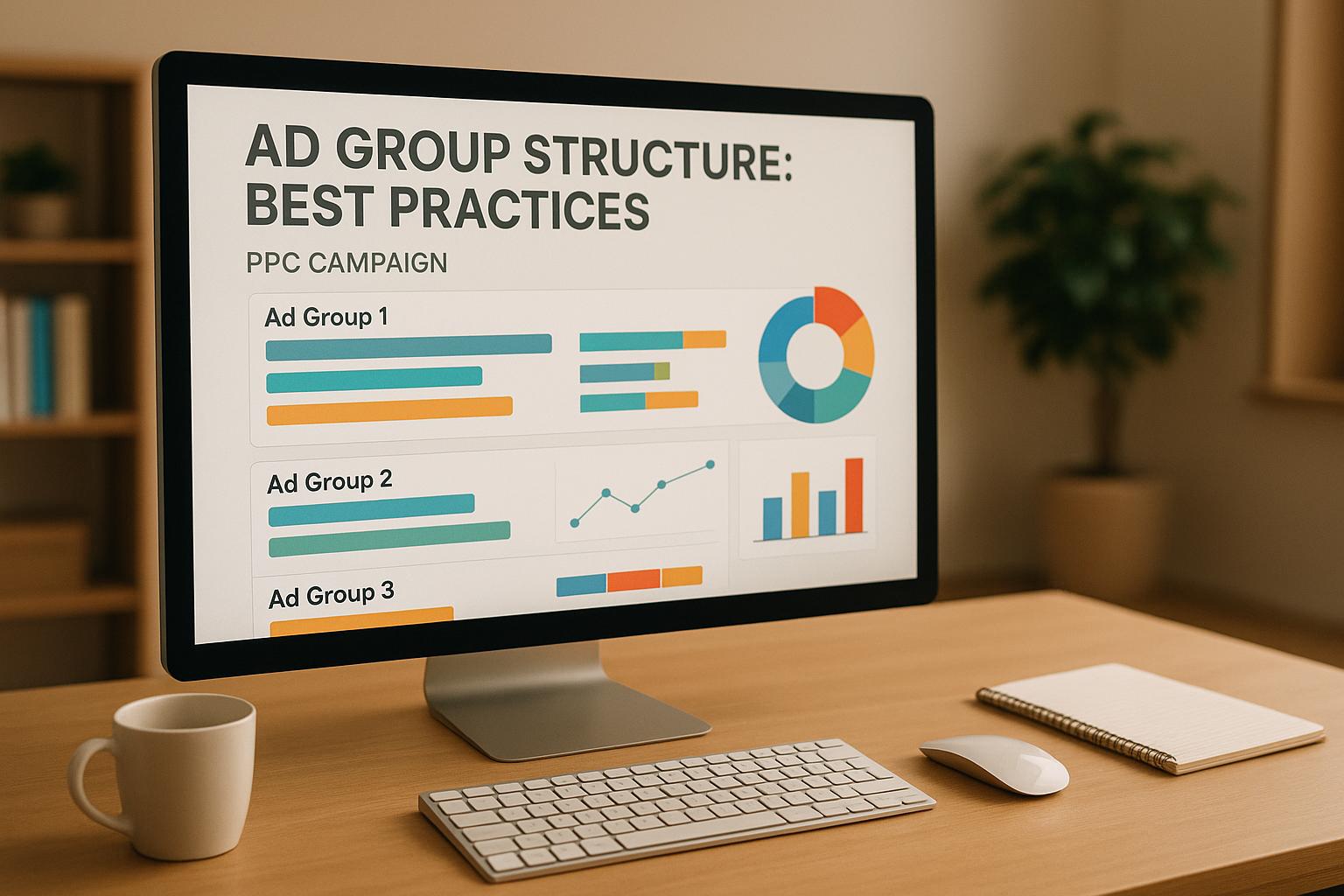Tracking your monthly PPC budget is essential to avoid overspending, optimize campaigns, and maximize ROI. Here's the key takeaway: Monitor your spending daily, adjust based on performance, and use tools or spreadsheets to stay on track.
Quick Steps to Manage Your PPC Budget:
- Set daily targets: Divide your monthly budget by the number of days to calculate a daily spend goal.
- Track key metrics: Focus on spend-to-date percentage, CPA (cost-per-acquisition), and ROAS (return on ad spend).
- Use tools or spreadsheets: Automate tracking with dashboards or manually record data for detailed insights.
- Adjust as needed: Reallocate funds from underperforming campaigns to high-performing ones.
- Review reports monthly: Analyze performance, identify trends, and refine your strategy.
By consistently tracking and adjusting, you ensure your PPC campaigns deliver results without exceeding your budget.
How to Manage and Track Your PPC Budget in 2025
Setting Up Monthly PPC Budget Parameters
To manage your PPC campaigns effectively, start by establishing clear budget parameters. These should align with your goals, historical performance, and operational systems. These parameters will help you track spending systematically and make timely adjustments, as detailed in later sections.
How to Set a Monthly Budget
A solid, data-driven monthly budget is the foundation for tracking your PPC performance and linking spending to outcomes.
For revenue-based budgeting, use this formula: PPC Budget = Target Revenue / (Conversion Rate x Average Order Value). Let’s say you aim for $50,000 in monthly revenue, have a 5% conversion rate, and an average order value of $200. In this case, your monthly PPC budget would be $5,000.
For conversion-based budgeting, the formula is: PPC Budget = (Desired Conversions x Average CPC) / Conversion Rate. For instance, if you need 100 conversions per month, your average cost-per-click is $3.00, and your conversion rate is 4%, your budget would total $7,500.
When setting your budget, rely on historical data and industry benchmarks. For example, conversion rates for platforms like Google Ads (7.04%), Facebook Ads (9.2%), and Bing Ads (2.8%) can help you gauge performance expectations.
"I always start with the target cost to acquire a customer or CAC. If you don't know that number, calculate one based on the average customer lifetime value and determine how much you can afford to spend on advertising while maintaining a healthy profit margin." – Brooke Webber, head of marketing at Ninja Patches
Budget requirements also vary by industry. With the average global CPC at $2.30 and Google Ads averaging $2.50, more competitive sectors like legal services or insurance will demand higher budgets. Research your industry’s typical cost-per-acquisition, which averages around $80 globally, to set realistic spending goals.
Don’t overlook seasonal trends or market conditions. For example, a small e-commerce business with a $2,000 monthly PPC budget might allocate 50% ($1,000) to Google Search Ads, 30% ($600) to Facebook Ads for retargeting, and 20% ($400) for testing new keywords on the Google Display Network. This approach balances proven channels with room for experimentation.
Recording Budget and Goals
Keep your budget organized by documenting the total allocation, daily spending targets (e.g., $6,000 divided over 28 days equals $214.29 per day), and platform-specific breakdowns.
Clearly define goals and success metrics for each campaign. For example, a SaaS company with a $10,000 monthly PPC budget might allocate 40% ($4,000) to Google Ads for high-intent search queries, 25% ($2,500) to LinkedIn Ads targeting decision-makers, 15% ($1,500) to Facebook Ads for brand awareness, and 20% ($2,000) for flexible experimentation. Each allocation should include specific conversion goals and acceptable cost-per-acquisition ranges.
To ensure accountability, make sure all team members can access the budget record and understand the reasoning behind spending priorities. Include details about performance thresholds that trigger adjustments and identify who has the authority to make changes. This transparency minimizes confusion when quick campaign optimizations are needed.
"Tracking is an essential part of any PPC campaign, especially for budgeting purposes. It's crucial to set an optimal budget where return on ad spend (ROAS) is growing year over year." – Rambod Yadegar, co-founder and president of HawkSEM
Regularly review your budget parameters to ensure they remain aligned with market conditions. What worked last month might not be the best strategy now.
Finally, include contingency plans for unexpected campaign surges or cost increases. This flexibility allows you to adapt quickly without disrupting your overall budget strategy.
Building Budget Tracking Systems
Once you've set your monthly PPC budget, the next step is creating systems to monitor your spending as it happens. Whether you prefer hands-on control or automated convenience, there are two effective ways to track your budget: manual spreadsheets and automated dashboards. Let’s dive into both.
Manual Tracking with Spreadsheets
Tools like Excel and Google Sheets let you build a customized budget tracker. You can monitor daily spending, cumulative totals, and pacing metrics, and even organize data by platform if needed.
Start by setting a target daily spend, calculated as Monthly Budget ÷ Days in Month. Then, track pacing using this formula: (Actual Spend ÷ Target Spend-to-Date) × 100. For a visual cue, use conditional formatting - mark anything over 105% in yellow and over 115% in red.
Here’s a quick example: If your monthly budget is $6,000 for a 30-day month, your target daily spend is $200. By day 7, if you’ve spent $1,400 (your target to date), your pacing is 100%. However, if you’ve spent $1,600, your pacing jumps to 114%, signaling a potential issue.
To get deeper insights, add columns for metrics like cost-per-click (CPC), conversion rate, and cost-per-acquisition (CPA). These help you link spending patterns to campaign performance.
Wrap it up with a weekly summary. This should include your average daily spend, projected month-end totals based on current pacing, and any campaigns that might need adjustments.
Automated Dashboards and Tools
If manual tracking feels like too much work, automated tools can save you time and effort. These systems pull data straight from your ad accounts and update continuously, giving you real-time insights without the hassle of manual entry.
Automated tools offer several perks:
- Real-time budget updates
- Alerts for overspending or underspending
- Cross-platform comparisons
- Identification of budget-capped campaigns, along with suggestions for improving performance
When choosing a tool, prioritize ones that provide daily or real-time updates. Look for features like budget alerts and performance improvement recommendations to keep your campaigns running smoothly.
For a curated list of tools, check out the Top PPC Marketing Directory (https://ppcmarketinghub.com). It’s a great resource to compare budget tracking solutions and other PPC tools, helping you find the right fit for your needs.
"Conversion tracking is vital. Take the time to set it up properly and ensure the ads are generating profit."
– Adam Palmer, President, Inertia Digital Marketing
"Ultimately, the key to demonstrating the success of your PPC campaigns is to provide clear and transparent reporting that shows how your services are directly contributing to your clients' business objectives."
– Justin Hoffman, Marketing & Sales, Web Solutions Firm
Choose a system that works with your workflow to ensure consistent and accurate budget tracking throughout the month.
sbb-itb-89b8f36
Monitoring and Adjusting Budget Usage
Once your tracking system is set up, the real work begins: keeping a close eye on your spending and making adjustments as needed. This ongoing effort is what sets effective PPC managers apart from those who simply set a budget and hope for the best.
Comparing Spend to Pacing Targets
Ad pacing is all about ensuring your budget is spent evenly over time, avoiding situations where funds run out too early or are left unspent. To do this, you need clear benchmarks and regular progress checks.
Start by using your daily budget target as a baseline for comparisons. Then, calculate your pacing percentage with this formula: (Actual Spend ÷ Target Spend-to-Date) × 100. A result of 100% means you're perfectly on track, while a figure like 115% shows you're spending 15% faster than planned.
Google Ads provides several tools to make this process easier. The Campaign Dashboard shows daily spending against your set limits, the Insights Tab highlights spending patterns, and Budget Reports break down how your pacing aligns with your performance goals. During critical times - like new campaign launches or promotional events - check your pacing daily. At the very least, review spending patterns weekly to spot any major deviations. When your pacing is off, it's time to make adjustments based on the data.
Making Data-Driven Adjustments
When your pacing veers off course, quick, targeted adjustments can prevent small issues from becoming big problems. Whether you're underspending or overspending, you need to act strategically.
For underspending campaigns, try boosting visibility by increasing bids, expanding your targeting to include more relevant keywords or locations, or using more aggressive bidding strategies during peak hours. On the other hand, for overspending campaigns, you might need to lower daily budgets, pause underperforming ad groups, refine your audience targeting, or adjust your ad schedule to focus on high-performance times.
Keep an eye on key metrics like CPA (cost per acquisition) and ROAS (return on ad spend) to ensure your adjustments make financial sense. For reference, the average CPA across industries is $48.96, and the average conversion rate in Google Ads is 3.75%. Use these benchmarks to gauge whether your campaigns are delivering enough value for the money you're spending.
Tools like Adalysis can help by tracking budget pacing hourly and projecting future spend based on current trends. It even sends alerts when campaigns stray from targets. Similarly, AgencyAnalytics automates budget tracking with its Goals feature, giving you a centralized dashboard to monitor spending across multiple campaigns.
Keep in mind that metrics should be viewed together. High spending might be perfectly fine if it results in strong conversion rates and a profitable ROAS. If you're optimizing your campaigns on a weekly basis, make sure your pacing reviews align with that schedule to ensure any budget adjustments support your overall performance goals.
Reporting and Analyzing Budget Performance
Transforming spending data into actionable steps starts with creating clear and effective budget reports. These reports should outline what occurred, the reasons behind it, and the next steps to take.
Building Monthly Budget Reports
A strong monthly budget report blends spending data with performance outcomes. It should compare planned versus actual spending and evaluate pacing accuracy while tying expenditures to measurable results.
Include performance metrics that directly link spending to outcomes. Focus on data like impressions, clicks, click-through rate (CTR), cost-per-click (CPC), conversion rate, cost-per-acquisition (CPA), and return on ad spend (ROAS). These metrics help determine whether your budget is delivering the desired results.
Visual aids like charts and graphs can make your data easier to interpret. For example:
- Line graphs can highlight trends over time, such as changes in CPC or ROAS.
- Bar charts are great for comparing performance across campaigns or ad groups.
- Pie charts can break down budget allocation by channel or campaign.
Structure your report by campaign or product line, and include concise explanations for any unusual data points. Adding industry benchmarks can also provide context for your performance, helping you see where you stand compared to others in your field.
By presenting this level of detail, your reports can uncover insights that guide smarter strategies moving forward.
Finding Actionable Insights
Use your reports not just to review past performance but to identify patterns and trends that can shape future decisions. These insights are key to refining your budget strategies and making timely adjustments.
For example, look for seasonal trends in your spending and performance data. These patterns can help you anticipate when to adjust budgets or bidding strategies.
Dive into keyword performance and conversion funnels to spot inefficiencies. If a campaign generates heavy clicks but few conversions, it might signal the need to optimize your landing pages or simplify conversion processes.
Evaluate your bids by identifying campaigns that consistently underperform or overspend. If a campaign delivers strong results but underspends, increasing bids might help capture additional volume. On the other hand, campaigns that overspend with limited returns may require a reassessment of targeting or bidding strategies.
Turn your analysis into actionable steps. For instance, if one channel consistently delivers a lower CPA than others, consider reallocating more budget or adjusting bids to maximize that channel’s impact.
Keep an eye on quality scores, as higher scores can reduce CPCs and improve ad placements. If you notice declining quality scores paired with rising costs, focus on enhancing your ad copy and landing pages.
Finally, document external factors like competitor activity, seasonal events, or market changes that may have influenced your budget performance. This additional context can help explain anomalies and inform better planning for the future.
Key Takeaways for PPC Budget Tracking
Here’s a streamlined overview of the essentials for effective PPC budget tracking:
- Allocate Your Budget Wisely: Aim to dedicate about 7–8% of your gross revenue to PPC campaigns. Keep in mind that most platforms require a minimum spend - around $1,000 for many, and at least $10,000 for LinkedIn campaigns.
- Choose the Right Platforms: Match your platform to your audience. For example, LinkedIn works well for B2B campaigns, while Facebook is often better suited for B2C efforts. This ensures your funds are spent where they’ll have the most impact.
- Track What Matters: Focus on metrics that directly affect your bottom line, like conversions, cost per conversion, and return on ad spend (ROAS). While impressions and clicks can provide useful early insights, conversion-driven data is key to understanding actual business results.
- Balance Prospecting and Retargeting: Allocate 60–70% of your budget to prospecting to attract new audiences, and 30–40% to retargeting campaigns to convert engaged prospects.
- Leverage Automation and Testing: Use platform automation to optimize bids and manage processes efficiently. Conduct targeted A/B testing to identify what’s driving performance and refine your approach.
- Start Small with Targeting: Begin with focused geographic targeting to avoid overspending in untested markets. Expand only after analyzing performance data. Continuously refine your audience by excluding irrelevant groups and search queries to keep costs down and efficiency up.
- Diversify Your Platforms: Avoid relying on a single channel. Spread your budget across multiple platforms to engage different audience segments and cover all stages of the marketing funnel. This not only broadens your reach but also provides a more complete picture of how your budget is performing.
FAQs
What are the most common mistakes to avoid when creating a PPC budget?
When managing a PPC budget, there are a few common missteps that can derail your efforts and waste valuable resources. One big mistake is not setting clear goals. Without well-defined objectives, it’s tough to allocate your budget in a way that drives meaningful results. Another frequent issue is placing unrealistic bids, which can drain your funds without yielding much in return.
Equally important is regularly tracking and optimizing your campaigns. Skipping this step means you could miss critical opportunities to tweak your approach for better performance. Spreading your budget too thin across too many channels is another pitfall - it often weakens your overall impact. And let’s not forget the importance of conversion tracking; failing to implement it can make it nearly impossible to measure success or improve ROI.
To get the most out of your PPC budget, prioritize smart targeting, test your ads consistently, and make sure your landing pages are designed to convert visitors into customers. These steps can help you avoid common errors and get the results you’re aiming for.
How can I tell if my PPC budget is being allocated effectively across platforms?
To make the most of your PPC budget, it's essential to keep a close eye on key performance metrics such as return on ad spend (ROAS), click-through rate (CTR), and conversion rate. These numbers give you a clear picture of which platforms are driving the best results for your investment.
Be flexible with your budget by shifting funds away from platforms that aren’t performing well and directing them toward those that yield a higher ROI. Regularly track performance and fine-tune your approach to ensure your budget is working as hard as it can to boost your campaign’s success.
How can I manage unexpected increases in PPC spending effectively?
To manage sudden increases in PPC spending, begin by establishing specific daily and campaign budgets to keep your costs in check. Use automated bidding strategies to dynamically adjust bids, helping to avoid unnecessary overspending. Keep a close eye on performance metrics in real-time, and be ready to pause ads that aren't performing well or tweak targeting if the market shifts unexpectedly.
On top of that, regularly analyze your campaign data to spot patterns and make smarter decisions about resource allocation. By pacing your budget thoughtfully and making frequent adjustments, you can stick to your monthly spending plan while still aiming for the best possible ROI.


